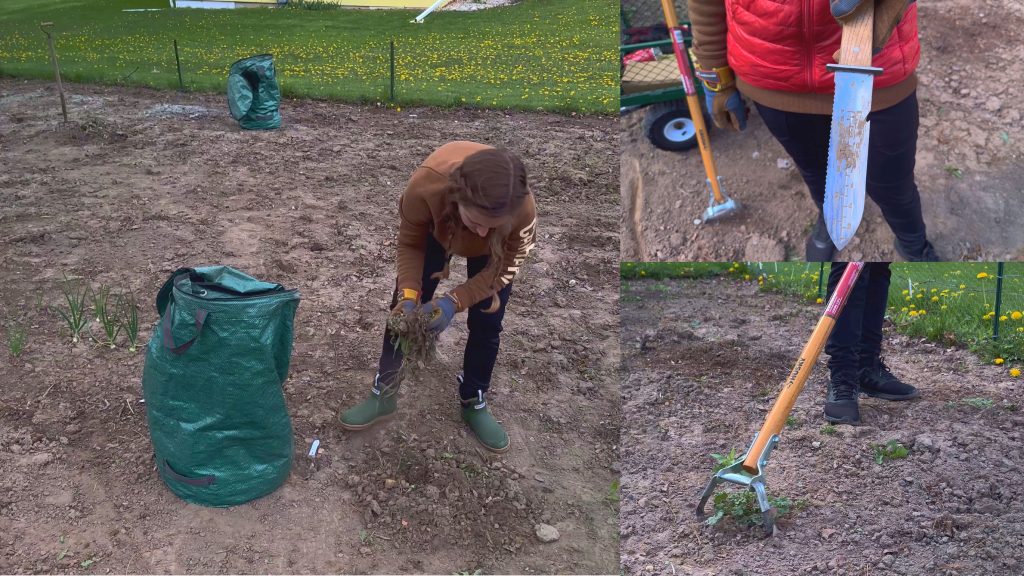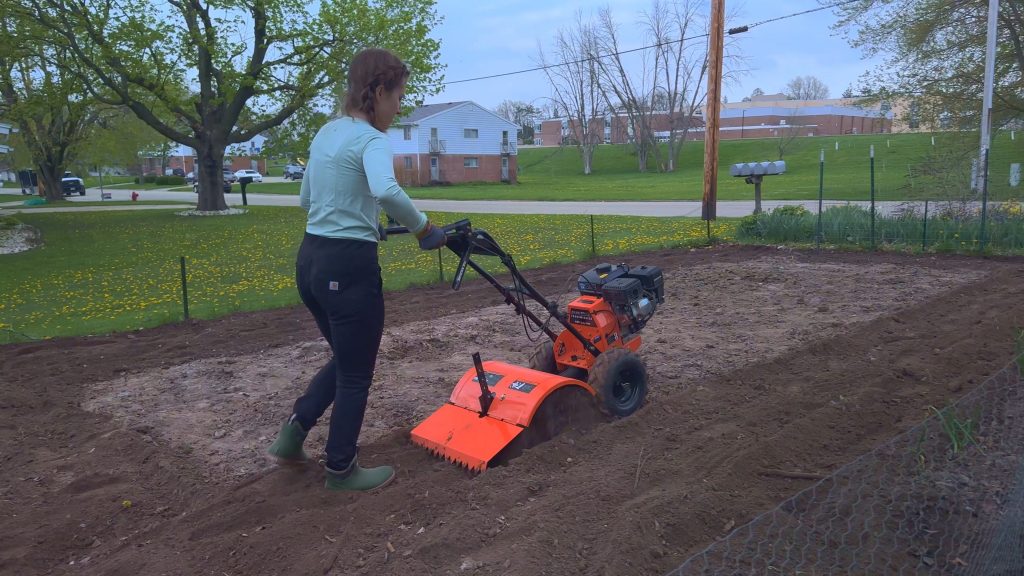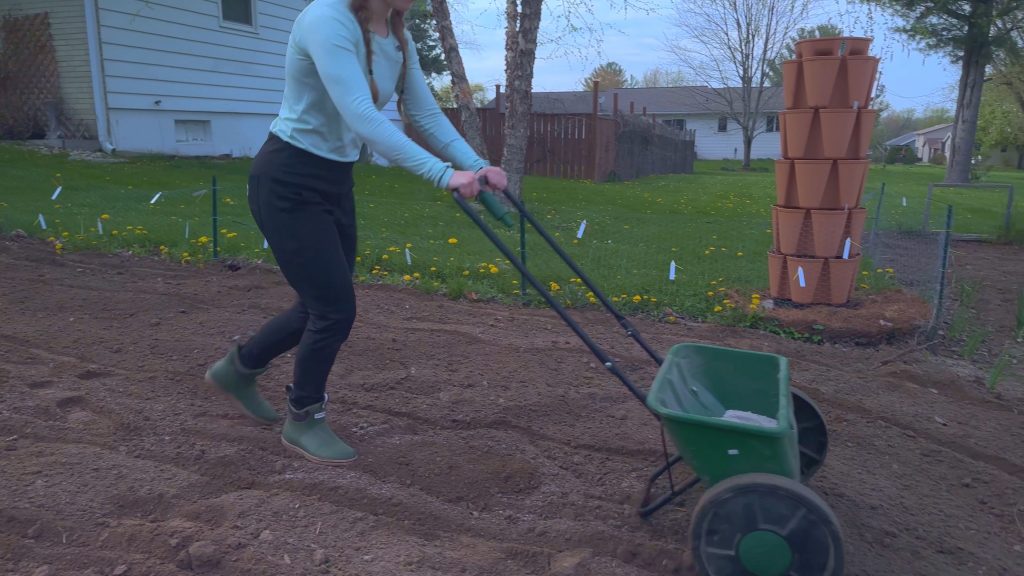Soil health is essential for strong, healthy plants! There’s definitely a lot to learn about soil health and how you can improve it. Sometimes all of the information can feel overwhelming. We break it down into easy steps in this article. We garden in south central Wisconsin in zone 5A and our main food garden is about 1,000 sq. ft. Read about the steps we are taking to improve our soil this year.

Step 1: Get a soil test
This is the first and most crucial step for improving the soil in your garden. You cannot improve what you don’t know. Please do not blindly fertilize your garden, you can do more harm than good! I recommend getting a soil test from a local university. We live in Wisconsin near UW-Madison so we had our soil tested at the UW Soil and Forage Lab. We did this in the fall after we were done gardening. The reason we did it in the fall was so we would have time to research in the winter and we’d be ready to apply what we learned come spring. You can also get them online, but I’ve read that it’s much better to get it done at a university. You can always mail in your sample if you don’t live near a university.
Step 2: Figure out your fertilizer
Another reason to get a soil test done early is so that you can have time to get to know your soil test. We read ours a few times before we completely understood it. The soil test contained a lot of information, but we also needed to look up certain terms and concepts to make sure we fully understood them before we could figure out a plan for fertilizer.
Your soil test will tell you how much of each nutrient you need for your garden. Then, you can research what you can apply to get that nutrient. And finally, you will need to figure out how much fertilizer you need. Let’s take a look at our soil test for an example.

Our soil test indicated that our soil needs nitrogen and potassium. We decided to go with blood meal and feather meal for our nitrogen needs. The reason that we went with these two is because feather meal releases slowly into the soil and blood meal releases faster. We wanted to have a combination of a fast-releasing fertilizer and a slow one. Here’s a screenshot of the equation from our soil test.

The feather meal and blood meal are both 12-0-0 and our nitrogen need is .3. So our equation was:
.3 / .12 = 2.5 lbs per 100 sq. ft.
We then needed to multiply this by 10 since our garden is 1,000 sq. ft. So in total, we needed 25 lbs in total of blood meal and feather meal. We split it evenly into 12.5 lbs of each.
You can repeat this for each type of fertilizer. For our potassium, we went with langbeinite. Langbeinite is 0-0-22. The potassium recommendation is meant to be split over two years, so after we figured out how much we needed, we split it in half and plan on adding the other half the following year.
Our equation was:
1 / .22 = 4.5 lbs per 100 sq. ft.
We multiplied by 10, and our total need was 45 lbs. of langbeinite. We divided this by 2 and only applied 22.5 lbs this year and will apply the same amount next year.
Depending on what fertilizer you go with, you will need to figure out when to apply it. This is another reason to get your soil tested early! What if you find out you need to apply something in the fall? Also, in the world we live in, shipping can take a while (if you’re not buying from a local garden center), so it gives you time to gather your materials.
Step 3: Remove weeds

Left: reusable garden waste bags
Top right: hori hori knife
Bottom right: hula hoe
Remove the weeds from your garden. You don’t want to till the weed seeds in. I know, everyone hates weeding, but it’s a necessity. Two tools you need to get your hands on to make the job easier are a hula hoe and a hori hori knife. They both make the weeding process a lot less painful. After you remove all of the weeds, try to leave them out on the soil for a few days to dry out. This makes it easier to rake all of them out from the garden. And it gives you a few days to rest from weeding. But, sometimes the weather doesn’t always work out like that, so don’t worry about letting them dry out too much. We use the green bags pictured above to help with clean up and then we have a local dump we can take them to. You don’t want to add weed seeds to your compost!
Step 4: Till garden

Till your garden. We know there is debate on this. We have a small space and we live in town, so we till. We don’t have the means to do a no-till method (yet). Right now, tilling is the best way for us to work with the land that we have. We don’t have access to enough compost or organic matter to do a no-till method. And honestly, we’re not at that level of gardening yet. We just started learning about no-till methods and want to learn more about them and incorporate them in the future. But, for now, we till our garden so that our soil is easier to work with. Also, you need to till the fertilizer into the first 3 inches of soil, so that’s another reason we are tilling.
Step 5: Spread fertilizer

Spread your fertilizer. A drop spreader works great for this. We had to spread the feather meal by hand because it was too fine to go through the spreader. But, it worked great for the blood meal and the langbeinite. After we spread the fertilizer, we tilled the whole garden again in order to work the fertilizer into the first 3 inches of the soil.
Conclusion
So there you have it, 5 simple steps you can take to improve the soil in your garden. Remember: healthy soil = healthy plants! Now let’s talk about timing. Our soil test indicated that nitrogen should be applied close to planting and potassium could be applied at any time. We completed this at the beginning of May. We are waiting a week before planting, then we will plant our beets and radishes in the garden. We do all of our major plants (tomatoes, peppers, eggplants, and more) around the end of May. If you want to see all of the plants we are planting in our garden, check out this video. Thanks for reading and I hope this article helped you break down the steps for improving the soil in your garden.


Itís nearly impossible to find well-informed people for this topic, but you seem like you know what youíre talking about! Thanks
May I simply say what a comfort to discover somebody who genuinely knows what they are talking about over the internet. You actually understand how to bring a problem to light and make it important. More people ought to check this out and understand this side of the story. I cant believe you arent more popular because you surely possess the gift.
I wanted to thank you for this very good read!! I absolutely loved every bit of it. Ive got you saved as a favorite to check out new things you postÖ
Howdy just wanted to give you a quick heads up. The words in your content seem
to be running off the screen in Opera. I’m not sure if this is a format issue or something to do with
internet browser compatibility but I figured I’d post to let you know.
The style and design look great though! Hope you
get the issue solved soon. Thanks
good!!!
I’ve been browsing online more than 2 hours today, yet I never found any interesting article like yours.
It’s pretty worth enough for me. In my view, if all site
owners and bloggers made good content as you did, the net will be
much more useful than ever before.